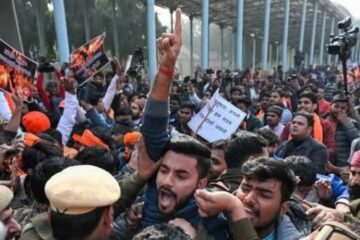The Tebhaga movement, which arose at the fag end of British rule in undivided India, was a significant peasant agitation initiated in Bengal. It is largely credited to the peasant front of the Communist Party of India—the All India Kisan Sabha.
At that time, landlords required tenant farmers and sharecroppers to give half of their crops to the landlords. The demand of the Tebhaga (sharing by thirds) movement was to reduce the landlords’ share to one-third.
In many areas, the agitation turned violent, and landlords fled, leaving parts of the countryside under the control of the Kisan Sabha. In 1946, sharecroppers began to assert that they would pay only one-third and that, before division, the harvested crop would remain in their own warehouses instead of those belonging to the Jotedars.
Jotedars were wealthy peasants or landlords who owned large landholdings in Bengal during British rule. They were powerful figures who controlled vast areas of land and often employed landless peasants as sharecroppers or labourers. While below the Zamindars in social standing, they held significant influence in rural Bengal.
The sharecroppers were encouraged by the fact that the Bengal Land Revenue Commission had already made this recommendation in its report to the government. The movement, however, resulted in violent clashes between Jotedars and sharecroppers.
The Bengal Land Revenue Commission, popularly known as the Floud Commission, had recommended in favour of the sharecroppers. It was the Bengal government under Sher-e-Bangla A K Fazlul Huq that had actually formed the Land Revenue Commission (generally known as the Floud Commission after its chairman, Francis Floud) with specific terms of reference concerning the end of the Permanent Settlement.
The Permanent Settlement was a grand contract signed in 1793 between the government of the East India Company in Bengal and individual landholders—Zamindars and Talukdars. Under this contract, the Zamindars were incorporated into the colonial state system as the absolute proprietors of landed property in Bengal.
The Floud Commission, which submitted its report in 1940, found the zamindari system untenable under the changed circumstances and recommended its immediate abolition, including all intermediate rent-receiving interests. Although the Floud Commission’s report remained unimplemented, communist leaders and activists such as Charu Majumdar, Ila Mitra, Haji Danesh, and many others waged movements to secure peasants’ rightful share of the crops they produced.
In response to the widespread Tebhaga movement, the Bengal government headed by Huseyn Shaheed Suhrawardy introduced two bills in early 1947—the State Acquisition and Tenancy Bill and the Bengal Bargadar (Provisional) Bill. The intention was to abolish the Permanent Settlement and improve the status of sharecropping tenants.
However, due to the politics of partition, the two bills could not be finally enacted into law. After partition, they were placed in the East Bengal Legislative Assembly in the form of a new bill called the East Bengal State Acquisition and Tenancy Bill, 1950. On 16 December 1950, the bill became law as the East Bengal State Acquisition and Tenancy Act, 1950. Under this Act, the Permanent Settlement was finally abolished.



